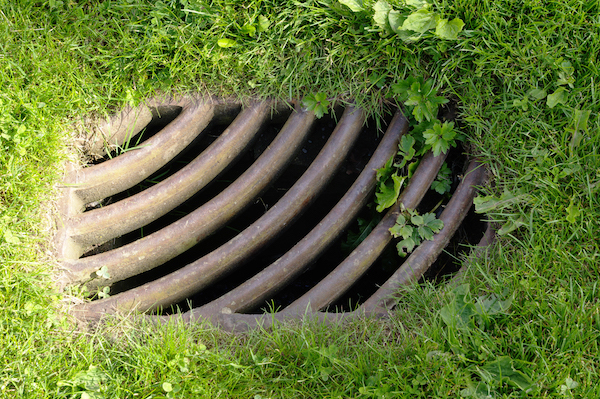A catch basin, or storm drain is simply a grate covered box that is available in many different materials and sizes. For commercial properties, parking lots and businesses, catch basin installation is crucial to ensure proper drainage for your parking surface and any surrounding landscape.
Since there are many different factors when it comes to installing catch basins, we want to provide you with the ABC’s of Catch Basin Installation.
Ideally, catch basin installation is done in the lower areas where the water collects the most. This helps prevent any drainage issues on asphalt or concrete. Water, along with solid debris will then flow into the box; the larger solids, like leaves and such will settle in the bottom. When the water levels begin to rise, the catch basin will reach the outlet trap and then flow into the local sewer drain system or watershed.
The first thing we do is determine the best location, or locations for your catch basins. As mentioned, the lowest place is generally a wise spot for at least one catch basin. After choosing all of the locations, the best piping routes will be determined that will have a gradual downward slope.
You may wonder how many catch basins are required for proper drainage. It all depends on the flow rate of stormwater at peak times. Other things to consider is the slope of the ground, the average rainfall amounts in Toledo, OH, along with the area of impermeable surfaces.
For example, a large parking lot in North Toledo, closer to the lake may require several catch basins, whereas in Sylvania, the same sized parking lot may not need as many.
The next step is to begin digging the trenches for the pipework. The equipment we use will largely be determined by the scope and sequence of the overall project. We always make sure to leave extra room in the trenches around the pipes so that we can ensure that the basin hole will properly line up with the outlet.
As soon as the trenching is complete, we will begin the installation process of the piping and basin. Before we physically place the basin in the ground, we install the adapters or plugs that connect to the pipes.
There are many different options when it comes to securing your catch basin – gravel, stone or concrete. Concrete offers the best protection from distortion. If we use gravel or stone, we will add a layer in the bottom of the hole before placing the basin on the ground. After which, we attach a heavy grate or commercial grate.
The way a catch basin handles debris is that they hold water below an elbow or outlet pipe. Standing water in the basin may contribute to the settling of sediment. Since oil floats to the top of the standing water, a catch basin can handle oil and grease if the water level is properly maintained.
A catch basin sump captures some solids during low water flow. The sump can’t capture or remove all particles. In general, larger particles are more easily contained by a sump. With regular maintenance, you can make the most of a catch basin’s ability to handle debris and pollution.
To prevent standing water, catch basins must be properly installed. When that doesn’t happen, it can lead to structural problems and could move a drainage problem from one area to another. When it’s time to outline your parking area, or surroundings of your property, give us a call at EK Contractors, and we will come out and assess your needs and provide you with an estimate of time and cost.


I’m planning on doing some oil changes in my garage, but I’m not sure what to do with the oil. It makes sense that I would want to get a catch basin installed so that I can collect it properly! That way, I can ensure that I get it recycled.